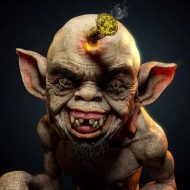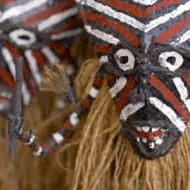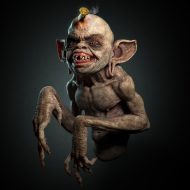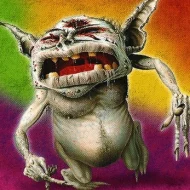Tokoloshe : The Water Spirit
Listen
At a glance
| Description | |
|---|---|
| Origin | Southern African Mythology |
| Classification | Spirits |
| Family Members | N/A |
| Region | South Africa, Zimbabwe |
| Associated With | Water, Misfortune |
Tokoloshe
Introduction
The Tokoloshe, a creature deeply rooted in Xhosa mythology, finds its dwelling place in the mythic landscapes of South Africa. While various descriptions of the Tokoloshe’s physical attributes exist, a consistent characteristic is its diminutive size. At times, it is portrayed as a small humanoid figure, while in other instances, its appearance leans towards a more primate-like form. This enigmatic being possesses a duality, oscillating between malevolence and benevolence in the narratives of folklore.
Notoriously mischievous and potentially dangerous, the Tokoloshe wreaks havoc by engaging in actions such as stealing souls, biting off toes, and inflicting illness upon unsuspecting individuals. However, there exists a contrasting dimension where the Tokoloshe can be invoked for benevolent purposes, serving as a means to scare children or protect against malevolent spirits. Depicted as a dwarf-like creature, the Tokoloshe is characterized by its hairy exterior, long claws, and luminous eyes, creating an eerie and unsettling visage.
The creature is closely associated with bodies of water, such as rivers, lakes, and swamps, establishing a mythical connection with aquatic realms. Intriguingly, the Tokoloshe is often linked with witchcraft and malevolence, further emphasizing its capacity for both mischief and harm. According to folklore, the Tokoloshe possesses the extraordinary ability to become invisible, achieved by either swallowing a stone or consuming water. This elusive trait renders the creature challenging to apprehend or fend off, contributing to the pervasive fear and superstitions surrounding its existence.
Physical Traits
Tokoloshe exhibit a range of distinctive physical traits that set them apart from other mythical beings. These traits include the ability to achieve invisibility by either drinking water or swallowing a stone. With sharp teeth and claws, Tokoloshe employ these appendages as formidable tools for attacking their victims. Additionally, their long hair serves to obscure their eyes and ears, adding to their mysterious and unsettling appearance. Further, Tokoloshe possess a tail, which serves the dual purpose of providing balance and being employed as a means to whip others. Horns or antlers adorning their heads are utilized for intimidation or charming purposes, reflecting the diversity of their physical manifestations across regions and cultural contexts.
The physical appearance of the Tokoloshe, although subject to variations based on geographical and cultural nuances, shares certain common characteristics. Characteristically small in stature, often likened to that of a child, Tokoloshe are typically hip-high. The presence of thick, dark fur covering their bodies is a recurring feature, contributing to their hairy exterior. Notably, their long claws, designed for scratching, grasping, and inflicting harm upon victims, remain a consistent aspect of their depiction. The Tokoloshe’s eyes are described as bright and piercing, with a tendency to glow in the dark, enhancing their eerie presence.
A particularly intriguing attribute of the Tokoloshe is its ability to achieve invisibility. This is accomplished by either consuming a stone or drinking water, rendering the creature elusive and challenging to detect or evade. This unique trait adds an element of mystery and complexity to the folklore surrounding the Tokoloshe, highlighting its adaptability and otherworldly nature.
Family
Tokoloshe, members of the Ngungunyane family, find their place among water spirits known as “the ones who live in the water.” This family, divided into two groups—Nguni and Nguniwe—features the more common and widespread Nguni, contrasting with the rarer and more secretive Nguniwe. The Nguni inhabit rivers, lakes, ponds, and streams, while the Nguniwe make their homes in underground caves and wells.
Regarded as the most mischievous and malevolent members of the Ngungunyane family, Tokoloshe often bring trouble to humans by stealing their souls, biting off their toes, or inflicting sickness upon them. Nevertheless, there are instances where Tokoloshe can exhibit helpful or friendly behavior towards humans who treat them with kindness and respect.
While the Tokoloshe is typically portrayed as a solitary creature, some narratives suggest the possibility of familial ties or even a kingdom. In certain tales, the Tokoloshe is depicted with a wife and children, sharing similar mischievous and malevolent traits. The presence of a “Queen of the Tokoloshes” is also mentioned in folklore, reigning over these creatures and their mysterious domain. Such intricate family dynamics contribute to the nuanced and multifaceted nature of Tokoloshe mythology within the broader context of the Ngungunyane water spirits.
Other names
Known by a myriad of names across different languages and cultures, the Tokoloshe reflects the cultural diversity and regional nuances of its mythological presence. In Southern Africa, it goes by Tikolosh and Thokolosi among Bantu-speaking communities, while the Zulu-speaking people of South Africa refer to it as Hili. In Zimbabwe, the Shona-speaking population recognizes it as Mwari or Mwari Mwari for both malevolent and benevolent water spirits. South Africa predominantly uses the name Tikoloshe, with Tokolosh being another popular variation. Additionally, the Shona people also call it Chihura, and the Xhosa people use the name Hilihili. These various monikers contribute to the rich and diverse cultural narrative surrounding the Tokoloshe, illustrating its enduring presence in the mythologies of different communities.
Powers and Abilities
Tokoloshe possesses an array of powers and abilities that render it a formidable entity with the potential to be either a menacing adversary or a valuable ally. Among these capabilities are the capacity to attain invisibility by either consuming water or swallowing a stone. This elusive trait makes them adept at navigating unseen, complicating efforts to detect or evade their presence. Additionally, Tokoloshe exhibits the power to control water and manipulate its flow, showcasing a connection to aquatic elements.
The creature’s repertoire extends to the realm of illusions and dreams, as it can create deceptive images and manipulate the dreamscapes of unsuspecting individuals. In a more sinister aspect, Tokoloshe can inflict diseases and infections through its bites or scratches, underscoring its malevolent potential. Moreover, it possesses the ability to cast curses, bringing about bad luck and misfortune to those unfortunate enough to cross its path.
Delving deeper into Tokoloshe’s mystical attributes, it is believed to wield a spectrum of powers, including shapeshifting. This allows the creature to alter its appearance, assuming disguises or taking on the form of animals. Teleportation is another extraordinary ability, enabling Tokoloshe to vanish and reappear at will, traversing vast distances in an instant.
Despite its diminutive size, Tokoloshe boasts superhuman strength, effortlessly overpowering humans. The creature is adept at illusion casting, using its abilities to deceive and manipulate unsuspecting victims. In some accounts, Tokoloshe is believed to possess the ability to steal vital essence, extracting the life force from its victims. This draining process is said to lead to illness or even death, emphasizing the potent and malevolent nature of this mythical creature.
Modern Day Influence
The Tokoloshe continues to exert its influence on modern-day culture and society, maintaining a significant presence in African folklore. It serves as a cautionary figure, woven into tales that admonish children to exhibit proper behavior and steer clear of perilous situations. Beyond oral traditions, the Tokoloshe has seamlessly integrated into contemporary popular culture, making appearances in films, literature, and video games, where its mystique captivates audiences.
This enduring relevance underscores the cultural importance of the Tokoloshe, emphasizing the lasting impact it has had on African communities. The creature stands as a testament to the richness of folklore and mythology across the continent, playing a vital role in shaping cultural identity and fostering a deeper understanding of ancestral narratives. Tokoloshes have become ubiquitous characters in South African comics, cartoons, movies, books, and games, with instances like Madam & Eve incorporating running gags involving these mythical entities.
Beyond the realms of visual storytelling, Tokoloshes find themselves in various artistic expressions, becoming subjects in art, music, and literature. John Kongos, for instance, contributed to the creature’s cultural presence by releasing a hit song titled “Tokoloshe Man” in 1972, a piece later covered by Happy Mondays. The Tokoloshe’s influence extends into the realm of superstition and folklore, where belief systems persist in using rituals or charms associated with these entities for protection or the attraction of good luck. A notable example is the practice of placing bricks under beds at night, believed to prevent Tokoloshes from nefarious activities such as stealing souls. In this way, the Tokoloshe continues to bridge the gap between traditional myth and the dynamic tapestry of contemporary culture, ensuring its legacy persists through the ages.
Related Images
Frequently Asked Questions
What is lorem Ipsum?
I am text block. Click edit button to change this text. Lorem ipsum dolor sit amet, consectetur adipiscing elit. Ut elit tellus, luctus nec ullamcorper mattis, pulvinar dapibus leo.
What is lorem Ipsum?
I am text block. Click edit button to change this text. Lorem ipsum dolor sit amet, consectetur adipiscing elit. Ut elit tellus, luctus nec ullamcorper mattis, pulvinar dapibus leo.
What is lorem Ipsum?
I am text block. Click edit button to change this text. Lorem ipsum dolor sit amet, consectetur adipiscing elit. Ut elit tellus, luctus nec ullamcorper mattis, pulvinar dapibus leo.
What is lorem Ipsum?
I am text block. Click edit button to change this text. Lorem ipsum dolor sit amet, consectetur adipiscing elit. Ut elit tellus, luctus nec ullamcorper mattis, pulvinar dapibus leo.
What is lorem Ipsum?
I am text block. Click edit button to change this text. Lorem ipsum dolor sit amet, consectetur adipiscing elit. Ut elit tellus, luctus nec ullamcorper mattis, pulvinar dapibus leo.








